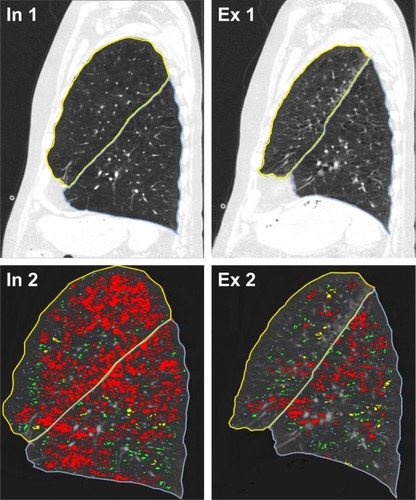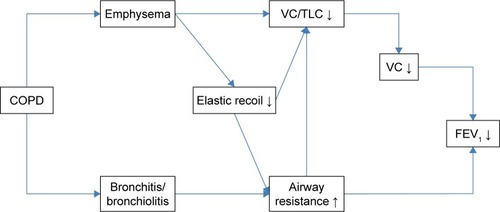Figures & data
Table 1 Baseline characteristics of the patients
Table 2 Lung volumes and densitometry of the patients
Figure 1 Example of a sagittal reconstruction of corresponding planes of the left lung in inspiration (In 1, In 2) and expiration (Ex 1, Ex 2).
Abbreviations: 15%P, 15th percentile of Hounsfield units; HU, Hounsfield unit; LAV, low attenuation value; LL, lower lobe; LVC/LTC, lobar vital capacity/lobar total capacity; MLD, mean lung density; UL, upper lobe.

Figure 2 Correlation coefficients (cc) between LVC/LTC and iMLD, iLAV, and i15%P [HU] in different shading, indicating the grade of correlation.
Abbreviations: HU, Hounsfield unit; i15%P, inspiratory 15th percentile of Hounsfield units; iLAV, inspiratory low attenuation value; iMLD, inspiratory mean lung density; LL, lower lobe; LVC/LTC, lobar vital capacity/lobar total capacity; UL, upper lobe.
![Figure 2 Correlation coefficients (cc) between LVC/LTC and iMLD, iLAV, and i15%P [HU] in different shading, indicating the grade of correlation.](/cms/asset/764c47c0-b4aa-4a45-9087-591875bbee7e/dcop_a_139304_f0002_b.jpg)
Figure 3 cc between LVC/LTC and eMLD, eLAV, and e15%P [HU] in different shading, indicating the grade of correlation.
Abbreviations: cc, correlation coefficient; e15%P, expiratory 15th percentile of Hounsfield units; eLAV, expiratory low attenuation value; eMLD, expiratory mean lung density; HU, Hounsfield unit; LL, lower lobe; LVC/LTC, lobar vital capacity/lobar total capacity; UL, upper lobe.
![Figure 3 cc between LVC/LTC and eMLD, eLAV, and e15%P [HU] in different shading, indicating the grade of correlation.](/cms/asset/3c38c72d-faab-445f-ad3d-225f9aa2eaa8/dcop_a_139304_f0003_b.jpg)

